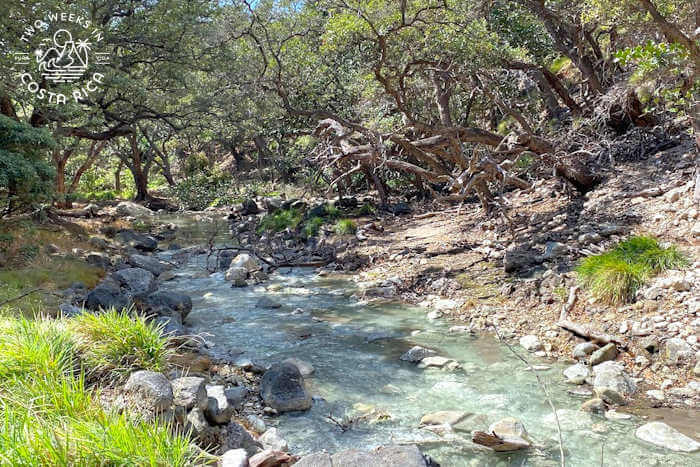A popular day trip to see volcanoes and tropical forest from Guanacaste is Rincon de la Vieja National Park. The most visited entrance of this park by far is Las Pailas sector. However, just a short distance away is a much more remote ranger station. In this post, we’ll tell you all about visiting the lesser known Rincon de la Vieja Santa Maria sector.
About Rincon de la Vieja National Park
Rincon de la Vieja National Park is a 14,300 hectare (35,336 acre) protected area in Guanacaste Province in northwestern Costa Rica.
The national park has two sectors: Las Pailas and Santa Maria. Between the two sectors, you can see a lot of volcanic features like steam vents, mud pots, acid pools, and hot springs.
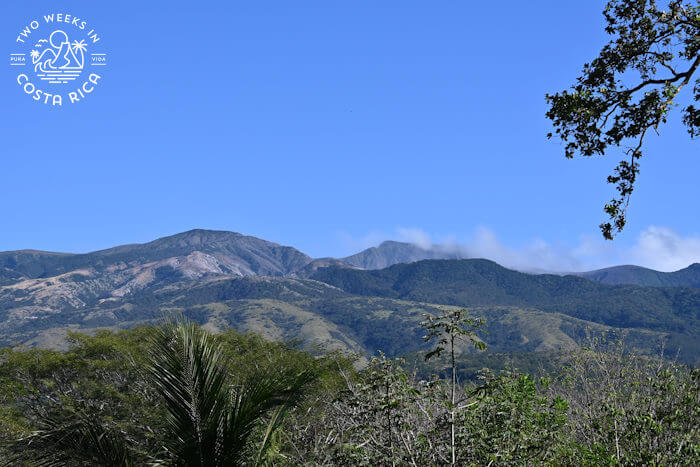
Additionally, the land around the national park has a lot to offer. In this rural area, you’ll find thick tropical forest, impressive river canyons, seasonal waterfalls, and sunny prairie-like fields.
For more information, read our post about the area, Curubande de Liberia: A Country Town Near Rincon de la Vieja.
Rincon is also a nice place to visit on a day trip from beach towns in Guanacaste like Tamarindo, Flamingo, Playas del Coco, and Playa Hermosa.
Rincon’s Santa Maria Sector
Rincon de la Vieja’s Santa Maria sector is a lot less visited than Las Pailas sector. This is probably because it is harder to access and doesn’t have as many volcanic features. As we explain below, though, it’s still well worth a visit.
For a full description of the trails at Las Pailas sector, read our post, Rincon de la Vieja National Park: Volcanic Vents and Tropical Forest.
How this Sector Compares
Rincon’s Santa Maria sector may not have as much variety when it comes to volcanic features, but it can be a great fit for some visitors.
The biggest draw is that the Santa Maria sector is not busy.
Las Pailas is a popular destination for package tourists and can have busloads of visitors at peak times. At Santa Maria, however, you may only see a handful of other people. During our visit in January (high season), we only saw six people on the trails, plus a few scientists doing research.
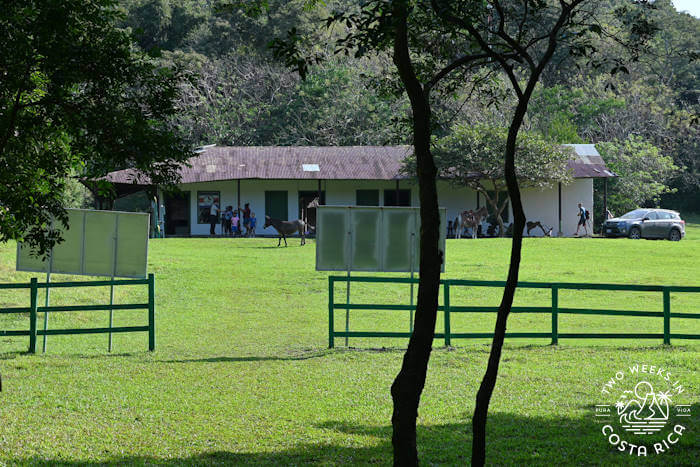
As far as difficulty, we’d say that for the average tourist, Las Pailas is the better choice. The trails are well kept and have bridges over all the streams.
The trails at the Santa Maria sector are more rustic (though still well kept) and you will need to cross some streams (see Trails section, below). These crossings could be a challenge, depending on recent rain.
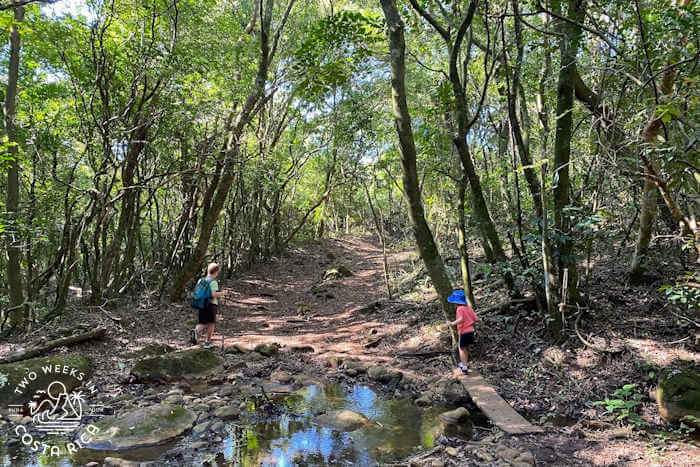
Trails Overview
Rincon de la Vieja National Park’s Santa Maria sector has one main trail that starts near the ranger station and ends at some beautiful natural hot springs.
Four shorter trails off the main trail lead to other points of interest like waterfalls. There is also a connecting trail that continues all the way to Las Pailas sector for those who want a challenge.
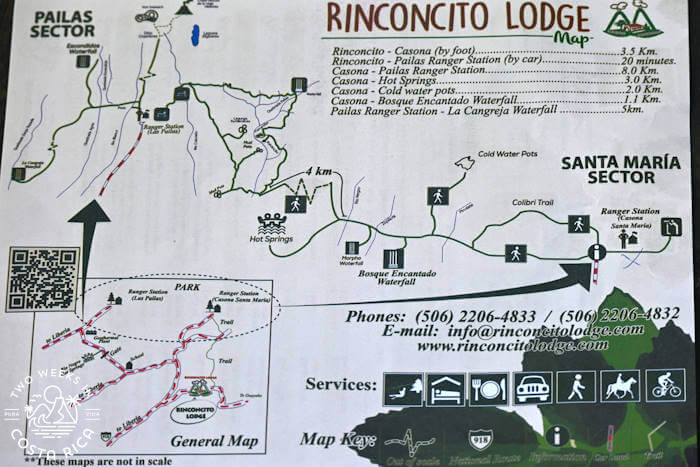
Note: A sign at the beginning of the hike gives roundtrip distances for each trail, which is a little confusing. For example, the main trail is 3 km (1.8 miles) each way, but the sign says it is 6 km (3.6 miles). Below we give the distances each way.
Hot Springs Trail (Sendero Aguas Termales) – 3 km (1.8 miles) each way
The main trail at the Santa Maria sector is the Hot Springs Trail.
This trail is mostly flat, but you do need to cross several streams.
During our visit (January), there hadn’t been much rain so we were able to cross most of the streams using rocks or logs. At one stream, however, we did have to wade through. During rainier times of year (May through November), crossing could be much more difficult.

The main trail ends at the focal point of the hike: a beautiful river with natural hot springs.

Like other rivers in the Rincon area, the volcano’s powerful thermal energy heats the water.
Although the park has created small pools with rocks that look inviting for swimming, you are not supposed to go in the water anymore (this was previously allowed). A small sign says that the pools are a sensitive environment and to not enter.
Instead, we walked along the rocks and dipped our toes. There’s also a shady spot to relax and have a snack/picnic before turning back. See note below regarding ticks in this area.
Side Trails
Four trails go off the Hot Springs Trail. Here is some information about them, listed in order starting at the ranger station.
Sendero Colibri (Hummingbird Trail) – 0.5 km (0.3 miles) long
The Hummingbird Trail starts just after the camping area/bathrooms on the right. It passes through thick forest and has some small ups and downs before looping back to the main trail.
Along the first part of the Hummingbird Trail, you can see the structural remains of an old sugar cane mill. Sugar cane is one of Guanacaste’s most important crops. The mill was part of a farm that existed before the national park was formed in 1973.
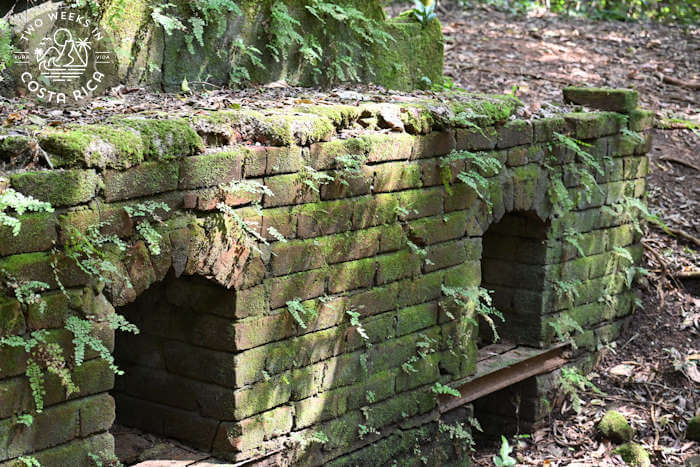
Sendero Pailas de Agua Fria (Cold Water Pots Trail) – 1 km (0.6 miles) each way
After hiking the main trail (Hot Springs Trail) for about 0.7 km (0.4 miles), you will come to the Cold Water Pots Trail on your right. We didn’t do this because the ranger warned us it might be too hard for our family (our kids were 4 and 8 at the time).
At the end of this trail there are supposed to be some interesting small pools with hot water bubbling up.
Sendero Bosque Encantado (Enchanted Forest Trail) – 100 meters (109 yards) each way
Next is the Enchanted Forest Trail. This short trail winds over some mossy rocks and around large primary forest trees. At the end is a swift stream with large boulders. There are multiple small waterfalls cascading down the slope.
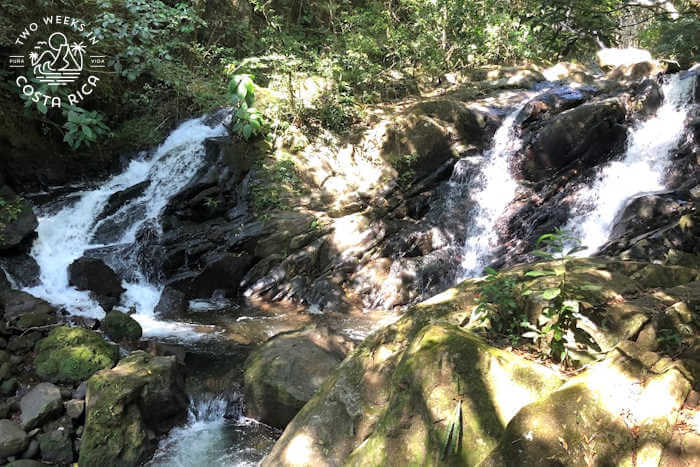
Sendero Morpho (Morpho Trail) – 300 meters (328 yards) each way
Shortly after the Enchanted Forest Trail is the Morpho Trail. This trail is easy but gets steep at the end when you climb down to the waterfall. At the bottom is a beautiful 4.5-meter (15-foot) cascade. This is a good place to do some swimming as long as the waterfall isn’t too strong.

Other Trails
There are two more trails in the Santa Maria sector.
The first goes to a mirador (lookout) behind the ranger station. This trail is a short 410 meters (437 yards) but was closed when we visited.
The other trail cuts off the Hot Springs Trail and leads all the way to Las Pailas sector. That trail is 8 km (5 miles) each way from ranger station to ranger station. The trail entrance is about halfway down the Hot Springs Trail.
What You’ll See on the Hike
Wild Forest
Besides the hot springs, the vast forest within the Santa Maria sector was the highlight for us. If you’re looking for a quiet place to appreciate nature, it’s a lovely spot. Along the trails, you can find dozens of different types of trees, bushes, cactuses, ferns, and interesting flowers.
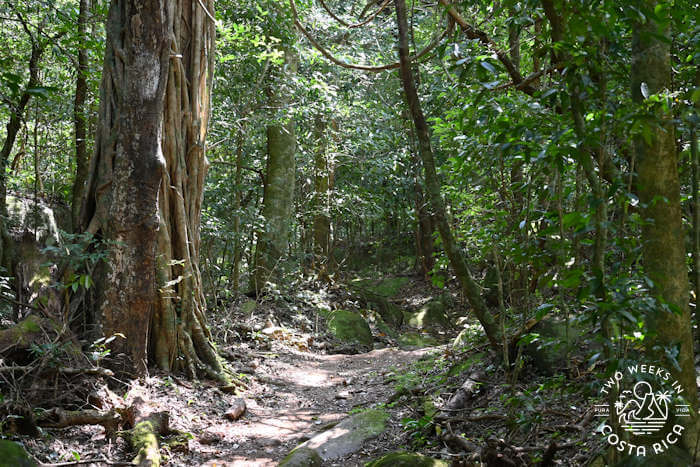
Animals
While we didn’t see many animals on our hike, the Santa Maria sector is home to a lot of wildlife. Deer, white-faced monkeys, tapir (Central America’s largest land mammal), peccary, and even jaguar can be found in the park with a little luck.
One wildlife highlight for us was seeing a family of spider monkeys. Spider monkeys are somewhat rare to see in Costa Rica and prefer very remote areas, so this was a special treat.
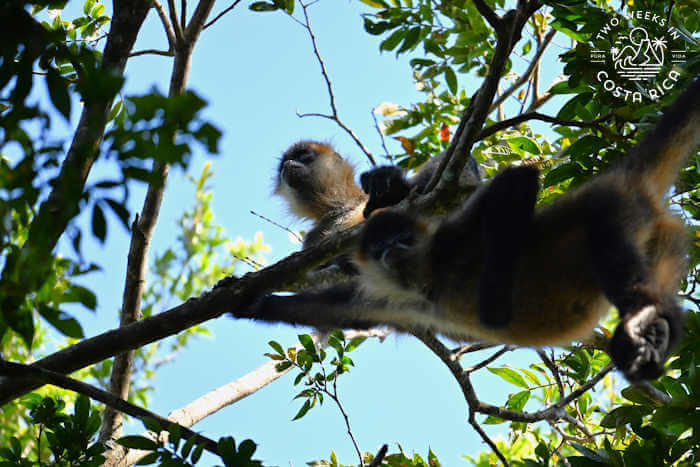
Birds
Much of the habitat we went through was tall trees. Although we could hear lots of birds up in the canopy, it was hard to spot them.
Two highlights were the Northern Barred-Woodcreeper and Pale-billed Woodpecker. We heard the woodpecker before we saw it, as it was busily pecking away at the side of a tree.
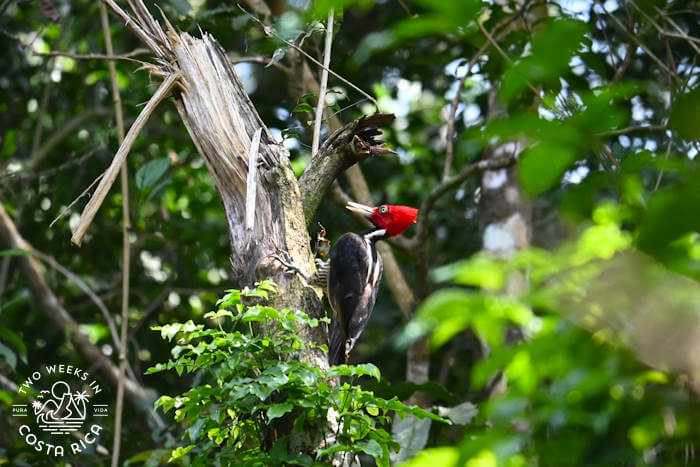
Insects
Insect lovers will love the Santa Maria sector. Walking slowly, we were able to see dozens of different bugs. There were caterpillars, hornets, bees, beetles, leafcutter ants, butterflies, cicadas, and much more.
We even saw a velvet ant, which is said to have one of the most painful stings in the world. In some places, similar species are called the cow killer. Surprisingly, these are not ants but a type of wingless wasp. Keep your distance!

Planning Your Visit to Rincon’s Santa Maria Sector
What to Bring/Wear
Insect Repellent (IMPORTANT!)
As soon as we arrived and opened our car door, small biting flies started attacking us. We quickly put on repellent and that did help.
Another major annoyance was ticks. After our visit, we found dozens of very small ticks/mites on our legs. We quickly removed them, but they left itchy bites for days. Our kids had the most, probably because they went off the trail more.
These pests probably change seasonally but the Santa Maria sector was wilder than we expected. We suggest staying on the trail, not brushing up against plants, wearing long pants, and using a good insect repellent. Check out our recommendations in our Packing post.
Food/Water
There are no stores in the area and nothing is sold at the ranger station. Be sure to bring everything you will need. Extra water is important since this area can be very hot and dry, with temperatures into mid-90s °F (35 °C) or hotter.
Clothing/Footwear
Lightweight, breathable clothing is best. Pants will help keep ticks off.
Wear closed-toed shoes because of ants and possible biting insects.
Buying Tickets
Tickets for Rincon de la Vieja National Park must be purchased in advance through the park service’s website. You need to register for an account first. English is available.
In-person tickets are not sold and you will be turned away or have to purchase them on your phone (if you have a signal). It’s best to buy in advance as the reservations’ system can be clunky.
Hours – Santa Maria Sector
Thursday to Monday, 8:00 a.m. to 3:30 p.m.
*Closed on Tuesday & Wednesday
Cost
Foreigners: $16.95 adults. $5.65 children (2-12 years old).
Citizens and Legal Residents: ₡1,130 adults, ₡565 children (2-12 years old).
Children under 2 are free.
Camping
The Santa Maria sector is one of the few national parks in Costa Rica that allows camping. They have raised platforms for tenting, potable water, a bathroom with showers, and grills you can use. The price is an extra $4 per person per day.
Accessibility
Rincon de la Vieja’s Santa Maria sector is not handicap-accessible. Las Pailas sector is a much better option for people with limited mobility. It has a paved universal trail.
Driving to Rincon de la Vieja’s Santa Maria Sector
From Curubande de Liberia or Hotel Hacienda Guachipelin
We drove from Hotel Hacienda Guachipelin near Las Pailas sector. To go this way, take the access road toward the Rio Negro Hot Springs. Continue past the springs and you will come to a gate. Someone working will open it for you. Note: To get back through later, you will need to have a hotel wristband or receipt from when you entered the Hacienda Guachipelin property.
Stay left at any splits in the road. Finally, you will come to a hairpin left turn, going up a hill. At the top there is a sign pointing to the Santa Maria sector. Continue on the gravel road to the park entrance. From Hotel Hacienda Guachipelin, the drive is about 30 minutes. No 4×4 required.
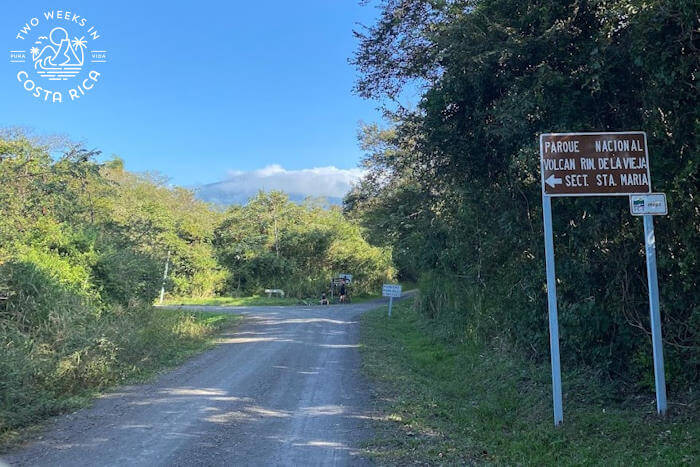
From Liberia
If you are coming from Liberia, you can drive through town to connect to Route 918. From Route 1, take Ave. 25 de Julio 11 blocks east. Then take a right onto Calle 7. Continue for 3 blocks and take a left onto Ave. 6/Route 918. This road continues into the countryside. After about 40-50 minutes, you will take a left to go toward the park entrance. Continue 10 more minutes and you will arrive. We are not sure of the road conditions (share in the comments if you go).
Conclusion
We didn’t know what to expect when visiting the Rincon de la Vieja Santa Maria sector. While we’re glad we did it, we probably would have enjoyed it more before having kids. The hike was a bit long for them, there wasn’t a ton of wildlife to see, and they were disappointed they couldn’t swim in the hot springs. That being said, us adults enjoyed it very much and would definitely go back.
Have a question about visiting Rincon’s Santa Maria sector? Leave a comment below.
Looking for more information to help plan your trip? Check out these posts:
Rincon de la Vieja National Park (Las Pailas Sector) – The much easier to access Las Pailas sector has lots of amazing volcanic features. Read our tips for visiting.
Oropendola Waterfall: An Easy-to-Access Waterfall in Guanacaste – This gorgeous waterfall is right outside Las Pailas sector.
Rio Negro Hot Springs – Heated by the same thermal energy as the national park, these nearby springs are perfect to soothe your sore muscles after hiking.

